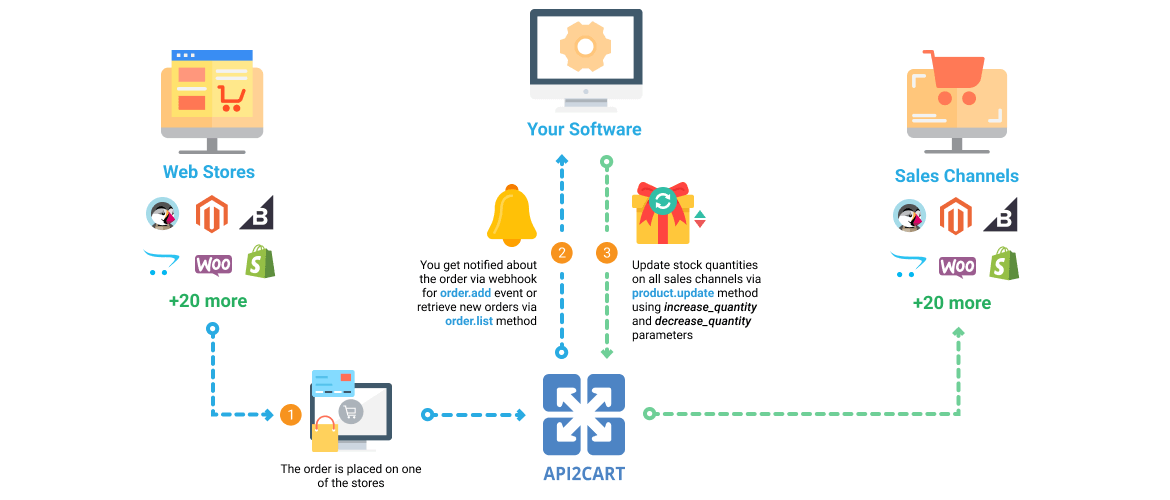
For eCommerce software providers, the ability to integrate with major platforms, such as Shopify is crucial to delivering value and automation to merchants. One of the most important aspects of this integration is the Shopify REST API to update products, which allows applications to modify product details such as price, inventory, descriptions, and variants in real time. Leveraging this feature enables your software to keep store data accurate and up to date, helping clients maintain a seamless shopping experience and reduce manual workload.
In this article, we’ll explore the key product updates to the Shopify API, what they mean for eCommerce software providers, and how to leverage these enhancements to stay competitive and deliver more value to your clients.
Product Updating on Shopify API
Shopify is one of the most widely used eCommerce platforms, powering millions of stores globally. It offers a robust set of APIs and tools that make it highly attractive for eCommerce software providers looking to build integrations for order management, inventory, shipping, and more. With its large merchant base, extensive app ecosystem, and strong developer support, Shopify provides a powerful and scalable foundation for delivering eCommerce solutions.
Managing product data across multiple eCommerce platforms can be complex—especially when dealing with constantly changing product information, such as prices, stock levels, descriptions, and images. For eCommerce software providers, offering a seamless way to update products on Shopify is a critical part of delivering real value to merchants.
eCommerce solutions such as ERP, PIM, order management, or automation tools often need to:
- Update stock levels in real-time;
- Synchronize product details across channels;
- Manage bulk changes to pricing or descriptions;
- Reflect supplier or warehouse updates in product listings;
Doing this efficiently and reliably requires direct integration with the Shopify shopping cart API or a middleware solution that simplifies this process.
To streamline updating product data efficiently, check our detailed guide on How to Update Product Info via API.

Why do eCommerce Software Solutions Need to Work with Product Data?
Product updates via Shopify's API are crucial for eCommerce SaaS (Software as a Service) solutions for several reasons. For eCommerce software providers, APIs (Application Programming Interfaces) offer a streamlined and automated way to integrate and update products. Here's why they matter:
1. Seamless Integration with External Systems:
eCommerce platforms often need to integrate with a wide variety of external systems, such as ERP (Enterprise Resource Planning) systems, CRMs (Customer Relationship Management), and other third-party services. APIs provide a standardized way to ensure that product data—like pricing, availability, images, and descriptions—can be easily updated across multiple platforms in real-time.
2. Automation and Efficiency:
Product updates via API enable automation, reducing the manual workload of eCommerce managers. Instead of having to manually upload or update product data, APIs allow for automated updates, ensuring that product catalogs are always up-to-date without extra effort. This is especially useful when dealing with large inventories or frequent product changes.
3. Real-Time Data Synchronization:
APIs facilitate real-time updates. This is particularly important in eCommerce, where price changes, stock levels, or promotions may need to be reflected immediately across all channels. For instance, if a product goes out of stock or has a price change, APIs allow that information to be pushed instantly to the front-end systems, ensuring that customers see the most accurate information.
4. Improved User Experience:
A smooth and up-to-date product catalog helps improve the overall user experience on eCommerce websites. Customers expect to see accurate product availability, prices, and details at all times. Product updates via API ensure this accuracy is maintained consistently, improving customer satisfaction and reducing cart abandonment due to outdated information.
5. Scaling and Flexibility:
As eCommerce businesses grow, manually updating product information becomes impractical. APIs allow SaaS solutions to scale seamlessly, as updates can be pushed automatically across many products without human intervention. This flexibility enables rapid growth without needing significant manual effort for each new product addition or update.
6. Customization and Personalization:
APIs enable eCommerce software providers to tailor product updates based on customer preferences or regional differences. For example, if certain products have different prices, availability, or promotional offers depending on the region, APIs allow the eCommerce platform to adjust content dynamically for each specific market, improving personalization for customers.
7. Data Consistency and Accuracy:
By relying on API-driven product updates, eCommerce providers can ensure that the data is consistent across all touchpoints (website, mobile app, in-store displays, etc.). This reduces errors, such as showing incorrect prices or outdated stock levels, which can lead to customer dissatisfaction or lost sales.
8. Faster Time to Market:
APIs streamline the process of adding new products or making updates. With automated workflows in place, new product features, launches, or pricing strategies can be deployed faster, giving businesses a competitive edge in the rapidly changing eCommerce landscape.
9. Reduced Human Error:
Manual data entry is prone to human error. APIs reduce the risk of errors associated with manual updates, leading to more accurate and reliable product data.
10. Cost Savings:
The efficiency gained from API-based product updates leads to cost savings in terms of time, resources, and operational overhead. Instead of dedicating extensive resources to manual product management, companies can reallocate those resources to more strategic initiatives.
For eCommerce software providers, implementing product updates via API is not just a technical benefit. It’s a competitive advantage that enhances operational efficiency, customer experience, and business scalability. In today’s fast-paced eCommerce environment, maintaining real-time synchronization of product data via APIs is essential for staying ahead of competitors and delivering a seamless and personalized shopping experience to customers.

How to Update Product Information on Shopify API via API2Cart Easily?
To update product on Shopify API via API2Cart, you can follow a streamlined process using their unified API. API2Cart is a third-party service that lets eCommerce software providers connect to multiple eCommerce platforms, including Shopify, through a single integration, making it much easier to manage product updates across different stores.
Managing product data efficiently is essential for any eCommerce software. If your system helps online retailers manage their inventory, product listings, or pricing, seamless integration with marketplaces, such as Shopify is crucial.
API2Cart offers a unified API that allows you to easily connect your software with Shopify and other eCommerce platforms. With this service, you can update products on Shopify without developing a separate integration from scratch.
Benefits of Using API2Cart for Shopify Product Updates:
- No need for separate integrations with each eCommerce platform;
- Saves development time;
- Handles versioning and API differences for you;
- Supports 60+ other eCommerce platforms and marketplaces, including Magento, WooCommerce, BigCommerce, OpenCart, PrestaShop, and others, at once, if you want to scale beyond Shopify.
Using API2Cart’s methods, you can:
- Update product details (title, description, SKU, images);
- Change prices or special offers;
- Modify stock levels;
- Edit product variants and attributes;
- Bulk updates multiple products at once.

Moreover, API2Cart provides 100+ API methods for easy managing, adding, updating, deleting the e-retailers stores’ data. You can work with products, product prices, orders, customer details, shipping info, etc. These methods are part of API2Cart’s unified API layer, which lets you interact with Shopify and other platforms, using a single interface:
- product.update: Update core product details (title, description, price, stock, etc.).
- product.list: Get all product IDs to reference for updates.
- product.image.add / product.image.update / product.image.delete: Use these to manage images for Shopify products. This is a more detailed description:
- product.image.add - Adds a new image to the product;
- product.image.update - Updates an existing image's URL or position;
- product.image.delete - Removes a specific image.
- product.variant.update: Update variant-specific details, such as size, color, variant price, or SKU.
Here’s a step-by-step guide to updating product information on Shopify via API2Cart:
- Set Up API2Cart:
- Sign up for an account on API2Cart;
- Generate your API key;
- Add the Shopify store to your API2Cart account using the store.add method. You’ll need the Shopify store URL and API credentials (Admin API access token).
- Identify the Product:
- Update Product Information:
- description;
- status (enabled/disabled);
- images;
- categories;
- meta_title, meta_description.
- Confirm the Update:
Use the product.list method to get the product ID if you don’t have it. This returns product details including id, which you’ll need to update specific products.
Use the product.update method to update data, such as price, name, SKU, quantity, etc.
You can update other fields too:
After calling product.update, check the response for return_code = 0, which means success.
For eCommerce software providers looking to streamline product management across platforms, API2Cart offers a powerful and flexible solution for updating product data on Shopify API. By leveraging API2Cart’s unified API, developers can avoid the complexities of Shopify’s native API and implement scalable, automated product update workflows with ease.
Whether you're managing inventory, syncing PIM data, updating pricing, or coordinating variant details, API2Cart provides the essential tools to make your integrations faster, more reliable, and ready for multichannel success. With support for 60+ eCommerce platforms and marketplaces, it's an ideal choice for SaaS providers aiming to scale across the eCommerce ecosystem.
Get started with a free trial today and see how it can transform your integration process. All you need to do is to book a FREE demo and contact our managers.
Conclusion
The Shopify API update product functionality is a powerful tool for eCommerce software providers looking to deliver seamless, automated, and scalable solutions. By integrating this capability into your platform, you empower merchants to keep their product data accurate, dynamic, and aligned with market demands—without manual intervention. Whether you're managing price updates, inventory syncing, or bulk product modifications, mastering this aspect of the Shopify API can significantly enhance the value and reliability of your software.
As Shopify continues to evolve, staying up to date with its API capabilities ensures your solution remains competitive and future-ready. With the right implementation strategies and attention to best practices, you can build integrations that not only meet your clients’ needs today but also scale with their business tomorrow.



